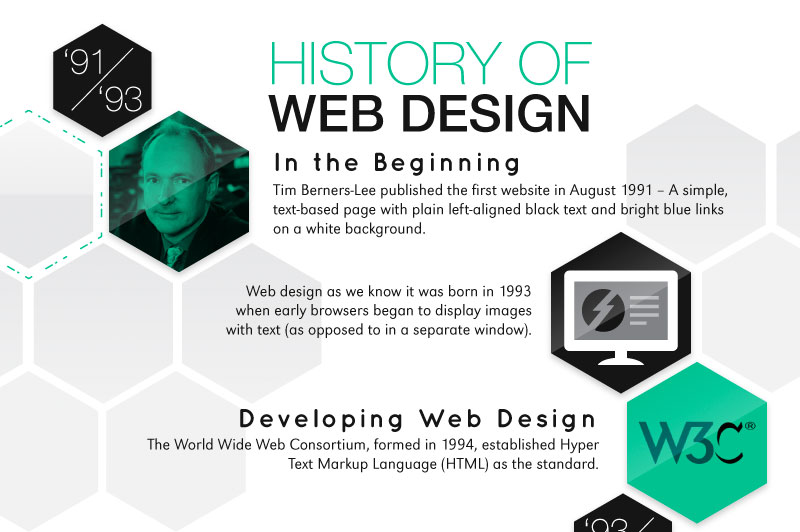Keen To Discover Just How Internet Site Style Has Changed With Time? Study The Development From Simplicity To User-Focused Experiences
Keen To Discover Just How Internet Site Style Has Changed With Time? Study The Development From Simplicity To User-Focused Experiences
Blog Article
Article Produced By-Hartley Bojesen
In the past, websites were simple and focused on details. Navigation was straight, and design was for desktop computers. Currently, individual experience is crucial. Information overviews layouts for very easy navigation. Receptive formats suit different devices. Today, dark setting lowers pressure, and minimalist food selections boost navigation. Interactive attributes involve users, and vibrant visuals stand apart. AI integration enhances interaction. See just how layout has evolved to improve your on the internet journey.
Very Early Days of Web Design
In the very early days of web design, simplicity preponderated. Internet sites were standard, with restricted colors, fonts, and formats. The emphasis got on giving info instead of showy visuals. Individuals accessed the net with slow dial-up links, so speed and performance were key.
Navigating menus were straightforward, normally situated at the top or side of the web page. Websites were designed for desktop computers, as mobile browsing wasn't yet widespread. Material was king, and designers focused on very easy readability over complex design aspects.
HTML was the primary coding language used, and designers had to function within its restraints. read the article and interactive functions were very little compared to today's requirements. Web sites were static, with little vibrant web content or customized customer experiences.
Increase of User-Focused Design
With the advancement of web site style, a shift towards user-focused layout principles has actually come to be progressively prominent. Today, producing sites that focus on individual experience is critical for involving visitors and achieving organization objectives. User-focused layout entails comprehending the demands, choices, and habits of your target market to customize the internet site's format, web content, and features accordingly.
Developers currently perform comprehensive study, such as customer studies and usability screening, to collect insights and responses straight from users. This data-driven strategy assists in producing user-friendly navigation, clear calls-to-action, and aesthetically enticing user interfaces that reverberate with visitors. By placing the customer at the facility of the layout process, sites can deliver a much more personalized and enjoyable experience.
Responsive design has also emerged as an essential facet of user-focused style, ensuring that websites are enhanced for different gadgets and display sizes. This adaptability improves ease of access and use, satisfying the diverse methods customers engage with internet sites today. Basically, the rise of user-focused style symbolizes a change in the direction of developing electronic experiences that focus on the requirements and assumptions of completion individual.
Modern Trends in Web Design
Explore the most up to date patterns forming web design today. One prominent fad is dark mode style, using a smooth and modern-day look while minimizing eye stress in low-light settings. Another essential trend is minimal navigating, simplifying food selections and boosting customer experience by concentrating on essential elements. Integrating micro-interactions, such as animated switches or scrolling effects, can produce a much more interesting and interactive internet site. Receptive style stays critical, making certain seamless user experiences throughout various gadgets. In addition, making use of bold typography and asymmetrical designs can add aesthetic passion and draw attention to details material.
Incorporating AI modern technology, like chatbots for consumer assistance or customized suggestions, improves customer involvement and simplifies procedures. Accessibility has likewise end up being a significant pattern, with developers prioritizing comprehensive style methods to deal with varied user needs. Welcoming sustainability by enhancing internet site performance for rate and efficiency is one more emerging trend in web design. Working together with customer feedback and information analytics to iterate and enhance style continuously is vital for staying appropriate in the ever-evolving electronic landscape. By embracing these contemporary fads, you can develop a visually enticing, easy to use site that resonates with your audience.
Conclusion
As you assess the evolution of website design from the early days to currently, you can see exactly how user-focused layout has come to be the driving pressure behind modern patterns.
Embrace the trip of adjustment and adjustment in web design, constantly maintaining the user experience at the forefront.
Remain current with the most recent patterns and modern technologies, and never ever quit advancing your technique to develop visually magnificent and easy to use websites.
Advance, adjust, and create - the future of website design is in your hands.
